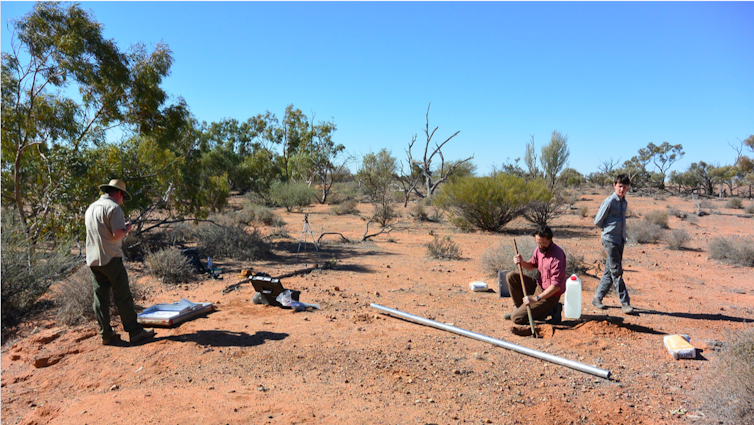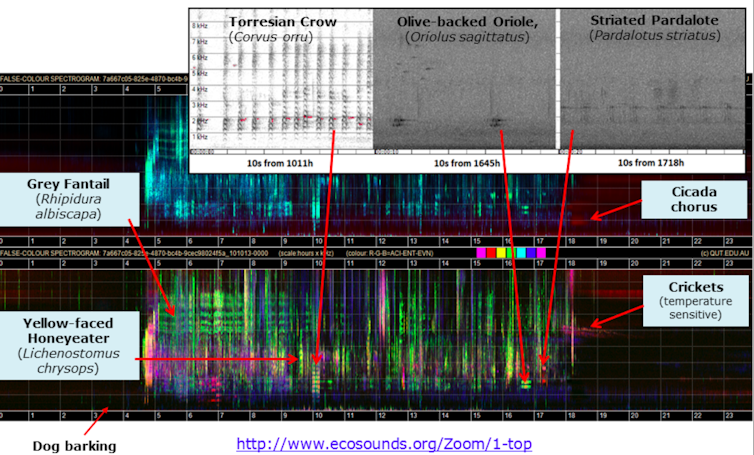World-first continental acoustic observatory will listen to the sounds of Australia
- Written by David M Watson, Professor in Ecology, Charles Sturt University
To me, the sound of a healthy wetland is like a symphony: crickets, frogs and splashing waterbirds; the dawn chorus with occasional jets flying overhead; even the odd donkey.
But add cane toads to the mix and it becomes a monotone dirge – the trilling, birdlike call of the toads and nothing else.
The significance of sound in ecosystems is what prompted my colleagues and me to develop a world-first acoustic observatory, made up of 400 permanent sensors embedded across the entire continent.
Three test sites, in inland woodlands, wetlands in Northern Australia, and subtropical forest remnants, have illustrated how we can use sound to track the movement of invasive species, the impact of climate change, and the health of remote ecosytems.
Now, with the support of five universities and a grant from the Australian Research Council, we are working to install acoustic sensors in ecosystems across Australia. By mid-2018 the full array will be in place. And once we begin recording, every minute will be made available to everybody online.
How it works
While audio has been used around the world in ecological research, Australia is the perfect candidate for a continent-wide recording array. We have many excellent ecologists and computer scientists concentrated in a small number of places, within a vast and sparsely populated country.
The difficulty of regularly visiting many parts of the nation, combined with the growth in digital technology and storage, means it is now feasible to leave recording devices in place for weeks – or in our case, years.
 By the middle of 2018, 400 sensors will be installed across Australia.
David Watson, Author provided
By the middle of 2018, 400 sensors will be installed across Australia.
David Watson, Author provided
Each array is built around a steel pole concreted into the ground. At the top is a solar panel, about the size of an A2 sheet of paper, which is connected to a battery to keep the digital recorder powered through overcast days.
We don’t yet have the ability to upload the data remotely (largely because of Australia’s lack of internet bandwidth), so for now we need to visit each array every six months or so to swap out the SD cards.
Once the data are collected, it will all be uploaded to the internet and made available for free. One of our hopes is that anyone with an interest in nature, from school teachers to artists and more people besides, will engage with this project.
Visualising time
One of the strengths of this project is our ability to use sound to picture time. We can prepare fascinating visualisations that contain months’ worth of data in a single image.
Some of the effects we’re measuring, such as the impact of cane toads and other invasive species, have very obvious acoustic signatures. They are dramatic to hear, but even more striking to see in a sonograph (essentially a graph of sound).
 A 24 hour recording rendered as a false-colour spectrogram. Different sound signatures are assigned colours, making patterns over time visible.
Michael Towsey, Anthony Truskinger, and Paul Roe
A 24 hour recording rendered as a false-colour spectrogram. Different sound signatures are assigned colours, making patterns over time visible.
Michael Towsey, Anthony Truskinger, and Paul Roe
We’ve pioneered the use of false-colour spectrograms to visualise long duration recordings. These make clear the flattening effect of invasive species, or the long-term subtle shifts caused by climate change.
The other major advantage of our remote arrays is that animals aren’t disturbed by humans frequently coming and going, which allows us to collect interesting and sometimes surprising data.
Read more: We made an app to identify bird sounds – and learned something surprising about people
Emus, for example, are attracted to shiny things – so a big shiny thing in the desert will catch their attention. And if you’ve heard them, you know they also have a pretty strange call, like a deep rolling boom.
When a big mob of 30 or so birds come across an array you can definitely hear it. From a nice quiet desert dune, with gusts of wind and small birds chirping, you’ll hear a little “oo-oo-oo”. And then there’s another, and another – and then it’s like a football crowd, with all of them investigating the array, pushing it around and mucking about with each other.
These continuous recordings of distinctly Australian soundscapes are surprisingly evocative. Ultimately, this acoustic observatory will not just allow environmental scientists to take the pulse of Australia’s ecosystem – it will also represent the most avant-garde radio imaginable, with 400 stations playing their own unique mix.
Authors: David M Watson, Professor in Ecology, Charles Sturt University




